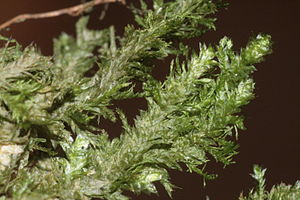Neckera pumila
| Neckera pumila | ||||||||||||
|---|---|---|---|---|---|---|---|---|---|---|---|---|

Neckera pumila |
||||||||||||
| Systematics | ||||||||||||
|
||||||||||||
| Scientific name | ||||||||||||
| Neckera pumila | ||||||||||||
| Hedw. |
Neckera pumila (Low Neckermoos) is aspecies of deciduous moss from the Neckeraceae family .
description
The species makes light green to dark green, somewhat shiny lawns. The secondary stems are up to 5 (maximum 10) centimeters long, flattened with leaves and pinnate. In addition to the short, normally leafy branches, there are very often thread-like, small-leaved, flagella-like shoots. These are used for vegetative reproduction.
The densely set, somewhat wavy, oblong-egg-shaped leaves are sharply pointed, the edges of the lower half of the leaf folded in on one side, bent back on the other and sawn in the upper part of the leaf. The leaf vein is short and double or often absent entirely.
The leaf cells in the middle of the leaf are linear, 5 to 8 µm wide and 5 to 6 times as long as they are wide, rhombic or oval towards the leaf tip. There are a few square cells in the leaf corners.
The moss is diocesan . Spore capsules are rarely formed. These are elongated ovoid, have a 3 to 5 millimeter long seta and are only slightly raised above the perichetial leaves. The cone-shaped capsule lid has a short beak. The spores are papilose and 14 to 20 µm in size.
distribution
Deposits are in Europe, with the exception of the eastern parts, also in Southwest Asia, in North Africa as well as in the Canary Islands and Madeira .
Location requirements
As an epiphyte , Neckera pumila grows mainly on the bark of deciduous trees, more rarely on conifers, occasionally even on rocks or old walls. The growth locations are in shady and humid forests from the plain to the montane altitude.
literature
- Jan-Peter Frahm , Wolfgang Frey : Moosflora (= UTB . 1250). 4th, revised and expanded edition. Ulmer, Stuttgart 2004, ISBN 3-8252-1250-5 .
- Martin Nebel, Georg Philippi (ed.): The mosses of Baden-Württemberg. Volume 2: Special part, (Bryophytina II, Schistostegales to Hypnobryales). Ulmer, Stuttgart 2001, ISBN 3-8001-3530-2 .